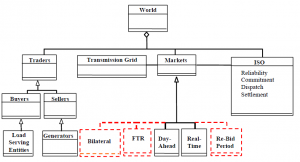Difference between revisions of "Agent-based computational economics"
(→Agent types and characteristics) |
(→Agent types and characteristics) |
||
| Line 56: | Line 56: | ||
Simple programmed agents are represented by simple algorithm, be it short lenght of a code or simplicity of a pseudo-random number generator agent uses (Shen). However even simple agents can exhibit form of swarm intelligence simillar to the emergent behavior of a group ants or termites. Groups of simple agents are than capable to solve complex tasks. Even without learning capability, the agents can optimize or generate orderly movement patterns. [http://en.wikipedia.org/wiki/Stigmergy Stigmergy] can be one way to achieve this. Agents can be differentiated by position in the [http://economistsview.typepad.com/economistsview/2009/02/cognitive-hierarchy-theory.html cognitive hierarchy], where more complex agents are able to think more steps ahead than simple agents. Smarter agents can also emulate behavior of simple agents if favourable but it's not possible vica versa. | Simple programmed agents are represented by simple algorithm, be it short lenght of a code or simplicity of a pseudo-random number generator agent uses (Shen). However even simple agents can exhibit form of swarm intelligence simillar to the emergent behavior of a group ants or termites. Groups of simple agents are than capable to solve complex tasks. Even without learning capability, the agents can optimize or generate orderly movement patterns. [http://en.wikipedia.org/wiki/Stigmergy Stigmergy] can be one way to achieve this. Agents can be differentiated by position in the [http://economistsview.typepad.com/economistsview/2009/02/cognitive-hierarchy-theory.html cognitive hierarchy], where more complex agents are able to think more steps ahead than simple agents. Smarter agents can also emulate behavior of simple agents if favourable but it's not possible vica versa. | ||
| − | |||
===Learning=== | ===Learning=== | ||
Revision as of 17:11, 19 June 2012
Contents
Resarch
Main pillars of ACE resarch[1]:
- Empirical
- Normative
- Qualitativ insight and theory generation
- Methodological advancement
Empirical
This area area stands for explaining possible reasons for observed regularities.
Normative
Qualitativ insight and theory generation
Methodological advancement
Fields of application
Double auction simulation Financial markets Labour markets Economic zones model
Computational world models
Computational world is composed of many agents, some of them can act on their own, have learning capability and memory. Others represent rather reactive elements of the world such as technology or nature. Some agents can be passive like house or patch of land. Composition of agents is also possible, music band agent can be for instance a composition of agents playing musical instruments. Agents are therefore ordered in hierachy as shown on AMES framework example. Agent can be simple-programmed, autonomous or human-like [2] In order for agents to operate in computational worlds, methods and protocols are required. These methods and protocols enable interactions between agents themselves, between agents and the world or artificial institutions e.g. market. These protocol consits of rules for mediation between agents and serve as description of interaction between agents e.g. between market and agent. [3] [4] For example in double auction model, agents may have following methods:
getWorldEventSchedule(clock time); getWorldProtocols (collusion, insolvency); getMarketProtocols (posting, matching, trade, settlement);
Equilibriums and attractors
Model behavior can result to various types of equilibrium and attractors. System is in equilibrium if all influences acting on the system offset each other so that the system is in an unchanging condition[5]. Agent-based models can help to determine which parameters influence stability or effectiveness of the market. Parameters can be changed on different levels e.g. agent level, market level or world level. Agent may have parameters like risk aversion, market may have parameters like non-employment payment percentage etc.[6]
Agent types and characteristics
Simple programmed agents are represented by simple algorithm, be it short lenght of a code or simplicity of a pseudo-random number generator agent uses (Shen). However even simple agents can exhibit form of swarm intelligence simillar to the emergent behavior of a group ants or termites. Groups of simple agents are than capable to solve complex tasks. Even without learning capability, the agents can optimize or generate orderly movement patterns. Stigmergy can be one way to achieve this. Agents can be differentiated by position in the cognitive hierarchy, where more complex agents are able to think more steps ahead than simple agents. Smarter agents can also emulate behavior of simple agents if favourable but it's not possible vica versa.
Learning
In order to capture dynamic nature of real markets agents must be able to learn which means change their behavior according to the situations they encounter. (zdroj) Agents in ACE can use various types of learning algorithms. Selection of an algorithm can fundamentally influence the results of the simulation[7]. Roth-Elev algorithm is one of the possible choices:
Other computing methods
Linear Equations and Iterative Methods (Currently empty) Optimization Nonlinear Equations Approximation Numerical Integration and Differentiation Monte Carlo and Simulation Methods (Currently empty) Quasi-Monte Carlo Methods (Currently empty) Finite Difference Methods (Currently empty) Projection Methods for Functional Equations (Currently empty) Numerical Dynamic Programming (Currently empty) Regular Perturbations of Simple Systems (Currently empty) Regular Perturbations in Multidimensional Systems (Currently empty) Advanced Asymptotic Methods (Currently empty) Solution Methods for Perfect Foresight Models (Currently empty) Solving Rational Expectations Models
References
- ↑ TESFATSION, Leigh. Agent-Based Computational Economics: Growing Economies from the Bottom Up. IOWA STATE UNIVERSITY. Agent-Based Computational Economics [online]. 2012-05-02, 2012-05-02 [cit. 2012-06-18]. Dostupné z: http://www2.econ.iastate.edu/tesfatsi/ace.htm
- ↑ Chen,S.-H.,Varieties of agentsinagent-based computational economics: A historical and an interdisciplinary perspective. Journal of Economic Dynamics and Control(2011), doi:10.1016/j.jedc.2011.09.003, Available from: http://www.econ.iastate.edu/tesfatsi/ACEHistoricalSurvey.SHCheng2011.pdf
- ↑ TESFATSION, Leigh. Agent-Based Computational Economics: Modeling Economies as Complex Adaptive Systems [online]. 2010-03-24, [cit. 2012-06-18]. Dostupné z: http://www2.econ.iastate.edu/classes/econ308/tesfatsion/ACETutorial.pdf
- ↑ Template:Cite web
- ↑ http://dl.acm.org/citation.cfm?id=1531270
- ↑ TESFATSION, Leigh. Modeling Economies as Complex Adaptive Systems. Agent-Based Computational Economics: Modeling Economies as Complex Adaptive Systems [online]. 2010-03-24, 2010-03-24 [cit. 2012-06-18]. Dostupné z: http://www2.econ.iastate.edu/classes/econ308/tesfatsion/ACETutorial.pdf
- ↑ TESFATSION, Leigh. Modeling Economies as Complex Adaptive Systems. Agent-Based Computational Economics: Modeling Economies as Complex Adaptive Systems [online]. 2010-03-24, 2010-03-24 [cit. 2012-06-18]. Available at: http://www2.econ.iastate.edu/classes/econ308/tesfatsion/ACETutorial.pdf
